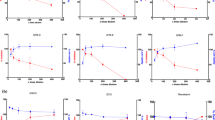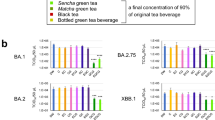Abstract
SARS-CoV-2 infects the oral mucosa and is shed in salivary fluids. Traditionally, tea has been used by various cultures to treat respiratory ailments. The objective of this study was to identify commercially available teas that can rapidly inactivate infectious SARS-CoV-2 in saliva. Initially, tea (n = 24) was prepared as 40 mg/mL infusions and incubated with SARS-CoV-2 resuspended in water, for 5 min at 37 °C. Then, five teas that showed >3 log reduction in virus infectivity were further investigated at 40 and 10 mg/mL infusions for 60 and 10 s contact time with SARS-CoV-2 resuspended in saliva. Tea polyphenols were measured using the Folin-Ciocalteu assay. SARS-CoV-2 infectivity was quantified on Vero-E6 cell line using TCID50 assay. At 10 mg/mL infusion, black tea showed the highest reduction (3 log, i.e., 99.9%) of infectious SARS-CoV-2 within 10 s. Green, mint medley, eucalyptus-mint, and raspberry zinger teas showed similar inactivation of SARS-CoV-2 (1.5–2 log, i.e., 96–99% reduction). At 40 mg/mL infusions, all five teas showed >3 log reduction in virus infectivity within 10 s. Tea polyphenol but not pH was significantly correlated to virus reduction. Time-of-addition assay revealed that the five teas displayed preventive effects (0.5–1 log, i.e., 68–90% reduction) against SARS-CoV-2 infection of Vero-E6 cells as well as during post-virus infection (1.2–1.9 log, i.e., 94–98%). However, the highest inhibitory effect was observed when the teas were added at the time of virus infection (2–3 log, i.e., 99–99.9%). Our results provide insights into a rapid at-home intervention (tea drinking or gargling) to reduce infectious SARS-CoV-2 load in the oral cavity which might also mitigate infection of the oral mucosa.




Similar content being viewed by others
References
Arora, I., White, S., & Mathews, R. (2023). Global dietary and herbal supplement use during COVID-19: A scoping review. Nutrients, 15, 771.
CDC. (2022). Symptoms of COVID-19. https://www.cdc.gov/coronavirus/2019-ncov/symptoms-testing/symptoms.html
Chou, O., Juang, Y. P., Chao, T. L., Tsai, S. F., Chiu, P. F., Chiou, C. T., Tsai, K. C., Chang, S. Y., Liang, P. H., & Wong, C. H. (2023). Isolation of anti-SARS-CoV-2 natural products extracted from Mentha canadensis and the semi-synthesis of antiviral derivatives. Journal of Natural Products, 86, 1428–1436.
D’Auria, J. C., Cohen, S. P., Leung, J., Glockzin, K., Glockzin, K. M., Gervay-Hague, J., Zhang, D., & Meinhardt, L. W. (2022). United States tea: A synopsis of ongoing tea research and solutions to United States tea production issues. Frontiers in Plant Science, 13, 934651.
Ding, S., Lee, J. S., Mohamed, M. A., & Ng, B. F. (2022). Infection risk of SARS-CoV-2 in a dining setting: Deposited droplets and aerosols. Building and Environment, 213, 108888.
Eggers, M., Jungke, P., Wolkinger, V., Bauer, R., Kessler, U., & Frank, B. (2022). Antiviral activity of plant juices and green tea against SARS-CoV-2 and influenza virus. Phytotherapy Research, 36, 2109–2115.
Ekanayake, A., & Li, J. (2004). Processing green tea extracts to make a beverage ingredient. In F. Shahidi & D. K. Weerasinghe (Ed.), Nutraceutical beveages. American Chemical Society.
Espano, E., Kim, J., Lee, K., & Kim, J. K. (2021). Phytochemicals for the treatment of COVID-19. Journal of Microbiology, 59, 959–977.
Esseili, M. A., Chin, A., Saif, L., Miller, S. A., Qu, F., Lewis Ivey, M. L., & Wang, Q. (2015). Postharvest survival of porcine sapovirus, a human norovirus surrogate, on phytopathogen-infected leafy greens. Journal of Food Protection, 78, 1472–1480.
Esseili, M. A., Mann, A., Narwankar, R., Kassem, I. I., Diez-Gonzalez, F., & Hogan, R. J. (2022). SARS-CoV-2 remains infectious for at least a month on artificially-contaminated frozen berries. Food Microbiology, 107, 104084.
Ge, J., Song, T., Li, M., Chen, W., Li, J., Gong, S., Zhao, Y., Ma, L., Yu, H., Li, X., & Fu, K. (2023). The medicinal value of tea drinking in the management of COVID-19. Heliyon, 9, e12968.
Goc, A., Sumera, W., Rath, M., & Niedzwiecki, A. (2021). Phenolic compounds disrupt spike-mediated receptor-binding and entry of SARS-CoV-2 pseudo-virions. PLoS ONE, 16, e0253489.
Harmer, D., Gilbert, M., Borman, R., & Clark, K. L. (2002). Quantitative mRNA expression profiling of ACE 2, a novel homologue of angiotensin converting enzyme. FEBS Letters, 532, 107–110.
Hirose, R., Nakaya, T., Naito, Y., Daidoji, T., Watanabe, Y., Yasuda, H., Konishi, H., & Itoh, Y. (2017). Mechanism of human influenza virus RNA persistence and virion survival in feces: Mucus protects virions from acid and digestive juices. Journal of Infectious Diseases, 216, 105–109.
Hudson, J. B. (1990). The choice and use of plant materials. In Antiviral compounds from plants. CRC Press.
Ishimoto, K., Hatanaka, N., Otani, S., Maeda, S., Xu, B., Yasugi, M., Moore, J. E., Suzuki, M., Nakagawa, S., & Yamasaki, S. (2022). Tea crude extracts effectively inactivate severe acute respiratory syndrome coronavirus 2. Letters in Applied Microbiology, 74, 2–7.
Iyer, P., Chino, T., & Ojcius, D. M. (2022). Infection of the oral cavity with SARS-CoV-2 variants: Scope of salivary diagnostics. Frontiers in Oral Health, 3, 1001790.
Jan, J. T., Cheng, T. R., Juang, Y. P., Ma, H. H., Wu, Y. T., Yang, W. B., Cheng, C. W., Chen, X., Chou, T. H., Shie, J. J., Cheng, W. C., Chein, R. J., Mao, S. S., Liang, P. H., Ma, C., Hung, S. C., & Wong, C. H. (2021). Identification of existing pharmaceuticals and herbal medicines as inhibitors of SARS-CoV-2 infection. Proceedings of the National Academy of Sciences of the United States of America, 118.
Kicker, E., Tittel, G., Schaller, T., Pferschy-Wenzig, E. M., Zatloukal, K., & Bauer, R. (2022). SARS-CoV-2 neutralizing activity of polyphenols in a special green tea extract preparation. Phytomedicine, 98, 153970.
Le-Trilling, V. T. K., Mennerich, D., Schuler, C., Sakson, R., Lill, J. K., Kasarla, S. S., Kopczynski, D., Loroch, S., Flores-Martinez, Y., Katschinski, B., Wohlgemuth, K., Gunzer, M., Meyer, F., Phapale, P., Dittmer, U., Sickmann, A., & Trilling, M. (2022). Identification of herbal teas and their compounds eliciting antiviral activity against SARS-CoV-2 in vitro. BMC Biology, 20, 264.
Liu, J., Bodnar, B. H., Meng, F., Khan, A. I., Wang, Xu., Saribas, S., Wang, T., Lohani, S. C., Wang, P., Wei, Z., Luo, J., Zhou, L., Jianguo, Wu., Luo, G., Li, Q., Wenhui, Hu., & Ho, W. (2021). Epigallocatechin gallate from green tea effectively blocks infection of SARS-CoV-2 and new variants by inhibiting spike binding to ACE2 receptor. Cell & Bioscience, 11, 168.
Marchesan, J. T., Warner, B. M., & Byrd, K. M. (2021). The “oral” history of COVID-19: Primary infection, salivary transmission, and post-acute implications. Journal of Periodontology, 92, 1357–1367.
Mieres-Castro, D., Ahmar, S., Shabbir, R., & Mora-Poblete, F. (2021). Antiviral activities of eucalyptus essential oils: Their effectiveness as therapeutic targets against human viruses. Pharmaceuticals (Basel), 14, 1210.
Nair, M. S., Huang, Y., Wang, M., & Weathers, P. J. (2023). SARS-CoV-2 omicron variants are susceptible in vitro to Artemisia annua hot water extracts. Journal of Ethnopharmacology, 308, 116291.
Ngwe Tun, M. M., Luvai, E., Nwe, K. M., Toume, K., Mizukami, S., Hirayama, K., Komatsu, K., & Morita, K. (2022). Anti-SARS-CoV-2 activity of various PET-bottled Japanese green teas and tea compounds in vitro. Archives of Virology, 167, 1547–1557.
Nishimura, H., Okamoto, M., Dapat, I., Katsumi, M., & Oshitani, H. (2021). Inactivation of SARS-CoV-2 by catechins from green tea. Japanese Journal of Infectious Diseases, 74, 421–423.
Ohgitani, E., Shin-Ya, M., Ichitani, M., Kobayashi, M., Takihara, T., Kawamoto, M., Kinugasa, H., & Mazda, O. (2021a). Rapid inactivation in vitro of SARS-CoV-2 in saliva by black tea and green tea. Pathogens, 10, 721.
Ohgitani, E., Shin-Ya, M., Ichitani, M., Kobayashi, M., Takihara, T., Kawamoto, M., Kinugasa, H., & Mazda, O. (2021b). Significant inactivation of SARS-CoV-2 in vitro by a green tea catechin, a catechin-derivative, and black tea galloylated theaflavins. Molecules, 26, 3572.
Ohishi, T., Hishiki, T., Baig, M. S., Rajpoot, S., Saqib, U., Takasaki, T., & Hara, Y. (2022). Epigallocatechin gallate (EGCG) attenuates severe acute respiratory coronavirus disease 2 (SARS-CoV-2) infection by blocking the interaction of SARS-CoV-2 spike protein receptor-binding domain to human angiotensin-converting enzyme 2. PLoS ONE, 17, e0271112.
Payment, P., & Trudel, M. (1993). Isolation and identification of viruses. In P. Payment & M. Trudel (Eds.), Methods and techniques in virology. Mercel Deckker.
Saulnier, A., Wendling, J. M., Hermant, B., & Lepelletier, D. (2023). SARS-CoV-2 transmission modes: Why and how contamination occurs around shared meals and drinks? Food Microbiology, 114, 104297.
Thakur, V., Ratho, R. K., Kumar, P., Bhatia, S. K., Bora, I., Mohi, G. K., Saxena, S. K., Devi, M., Yadav, D., & Mehariya, S. (2021). Multi-organ involvement in COVID-19: Beyond pulmonary manifestations. Journal of Clinical Medicine, 10, 446.
Umeoguaju, F. U., Ephraim-Emmanuel, B. C., Patrick-Iwuanyanwu, K. C., Zelikoff, J. T., & Orisakwe, O. E. (2021). Plant-derived food grade substances (PDFGS) active against respiratory viruses: A systematic review of non-clinical studies. Frontiers in Nutrition, 8, 606782.
Wang, Y., Xu, G., & Huang, Y. W. (2020). Modeling the load of SARS-CoV-2 virus in human expelled particles during coughing and speaking. PLoS ONE, 15, e0241539.
WHO. (2023). COVID-19 weekly epidemiological update. Accessed 8 August 2023. https://www.who.int/publications/m/item/weekly-epidemiological-update-on-covid-19---3-august-2023
Xu, H., Zhong, L., Deng, J., Peng, J., Dan, H., Zeng, X., Li, T., & Chen, Q. (2020). High expression of ACE2 receptor of 2019-nCoV on the epithelial cells of oral mucosa. International Journal of Oral Science, 12, 8.
Yamada, H., Takuma, N., Daimon, T., & Hara, Y. (2006). Gargling with tea catechin extracts for the prevention of influenza infection in elderly nursing home residents: A prospective clinical study. Journal of Alternative and Complementary Medicine, 12, 669–672.
Zhang, H., Li, H. B., Lyu, J. R., Lei, X. M., Li, W., Wu, G., Lyu, J., & Dai, Z. M. (2020). Specific ACE2 expression in small intestinal enterocytes may cause gastrointestinal symptoms and injury after 2019-nCoV infection. International Journal of Infectious Diseases, 96, 19–24.
Zhou, P., Yang, X. L., Wang, X. G., Hu, B., Zhang, L., Zhang, W., Si, H. R., Zhu, Y., Li, B., Huang, C. L., Chen, H. D., Chen, J., Luo, Y., Guo, H., Jiang, R. D., Liu, M. Q., Chen, Y., Shen, X. R., Wang, X., … Shi, Z. L. (2020). A pneumonia outbreak associated with a new coronavirus of probable bat origin. Nature, 579, 270–273.
Acknowledgements
The author would like to thank Ethan Guest for preparing Vero-E6 cell culture plates cells and Revati Narwankar for her help in MTT assay.
Funding
Esseili MA Faculty startup money from the University of Georgia.
University of Georgia, Startup Fund
Author information
Authors and Affiliations
Contributions
Esseili MA designed and conducted the experiments, analyzed the data, and wrote the manuscript. Morris JM: repeated independently the experiments and participated in writing manuscript drafts.
Corresponding author
Ethics declarations
Competing interests
The authors declare no competing interests.
Additional information
Publisher's Note
Springer Nature remains neutral with regard to jurisdictional claims in published maps and institutional affiliations.
Rights and permissions
Springer Nature or its licensor (e.g. a society or other partner) holds exclusive rights to this article under a publishing agreement with the author(s) or other rightsholder(s); author self-archiving of the accepted manuscript version of this article is solely governed by the terms of such publishing agreement and applicable law.
About this article
Cite this article
Morris, J.N., Esseili, M.A. Screening Commercial Tea for Rapid Inactivation of Infectious SARS-CoV-2 in Saliva. Food Environ Virol (2024). https://doi.org/10.1007/s12560-023-09581-0
Received:
Accepted:
Published:
DOI: https://doi.org/10.1007/s12560-023-09581-0




